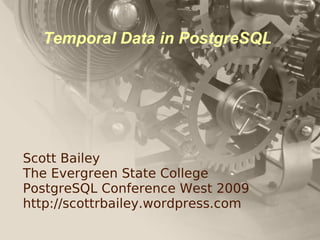
Temporal Data
- 1. Temporal Data in PostgreSQL Scott Bailey The Evergreen State College PostgreSQL Conference West 2009 http://scottrbailey.wordpress.com
- 2. Agenda ✗ Provided data types ✗ Extended data types ✗ Temporal Databases ✗ What is in store for PostgreSQL ✗ Tips, tricks and questions
- 3. Thinking About Time ✗ Temporal Quiz ✗ How many minutes in a day? ✗ How many seconds in a day? ✗ How long does it take the Earth to complete one rotation? ✗ Actually, what is a second? ✗ What number should be at the top of the clock? ✗ Extremely complicated!
- 4. Basic Data Types ✗ Timestamp &Timestamp with time zone ✗ Granularity 1 microsecond ✗ Can only subtract two timestamps and add/subtract with intervals. ✗ Timestamp with out time zone is default for compliance with SQL specification. ✗ Which should you use? ✗ Date ✗ Granularity 1 day ✗ Can add/subtract dates & integers
- 5. Basic Types Cont. ✗ Interval – a duration of time ✗ Granularity 1 microsecond ✗ Add/Subtract/Multiply/Divide ✗ Time / Time with time zone ✗ Granularity 1 microsecond ✗ Acts like both time and a (small) interval ✗ Timezone info is useless without date ✗ Depricated types ✗ abstime (Unix timestamp), reltime (limited interval), timespan (interval), tinterval (period)
- 6. Period Data Type ✗ Period – defines an anchored interval or timespan ✗ Often what we are modeling is not an instantaneous event but a period over which some state is true. ✗ Typically implemented as a start and end timestamp. Could be implemented with an anchor time and an interval. ✗ Theory has been around for a while. ✗ Current implementations – PgTemporal, Chronos ✗ Write down a period representing today. ✗ Can be open or closed intervals but are typically half- open. ✗ [ ] indicates endpoints are contained () not contained.
- 7. Period Data Type ✗ Why a half open interval? ✗ Period functions ✗ Positional ✗ before(), after(), adjacent(), overlaps(), overleft(), over- right(), starts(), ends() ✗ Containment ✗ contains(), contained_by() ✗ Manipulation ✗ shift(), grow(), shrink() ✗ Set functions – periods are contiguous sets ✗ period_union(), period_intersect(), period_minus(), period_exclude()
- 8. Period Issues ✗ When one end point is unknown ✗ Since – period(timestamp, NULL) ✗ Until – period(NULL, timestamp) not as common ✗ Hard to do much with infinity. ✗ Referential integrity ✗ Primary keys – exclusion, can't be two places at once. ✗ Foreign keys – containment, lifetime of child item must be contained by parent's lifetime.
- 9. Non-contiguous Time Sets ✗ Why would we need non-contiguous sets? ✗ Set functions for periods can be applied to arrays of periods! ✗ Now we can solve (pretty easily) in SQL what would have taken LOTS of procedural code. ✗ Period Arrays vs Non-Contiguous Sets Period Array NCS
- 10. Bitemporal Data ✗ “Temporal Database” vs temporal data ✗ Both Valid Time (VT) and Transaction Time (TT). ✗ Valid Time – A period for which a fact is true. ✗ Employee X was in position Y from A to B. ✗ Store not just the current fact but a historical record. ✗ Transaction Time – Records the time a row was inserted and superseded ✗ Provides time travel or temporal rollback. ✗ Very much like the MVCC approach in PostgreSQL. ✗ Logging transaction ids with timestamp would let us map xmin & xmax to times.
- 11. Current Implementations ✗ Lots of theory out there, very few actual implementations. ✗ Oracle – Currently the best implementation in a general purpose database. ✗ Workspace Manager – version enable tables ✗ Automatically renames table, adds versioning metadata (VT), creates view w/ original table name, and defines INSTEAD OF triggers for DML. ✗ Handles temporal constraints. ✗ Provides a period data type and a subset of the functions provided in pgTemporal, Chronos. ✗ Great implementation but solves only a single problem domain and does not allow you to reuse them.
- 12. The Future for PostgreSQL ✗ Version 8.5 ✗ Temporal keys and constraints ✗ Changes to the type system ✗ Period data type either added to core or as a contrib module! ✗ Version 8.6? ✗ Full support for periods, NCS, table versioning and time travel! ✗ Hands down the most complete temporal implementation of ANY general purpose database.
- 13. Additional Resources ✗ TSQL2 Specification - http://www.cs.arizona.edu/~rts/tsql2.html ✗ Developing Time-Oriented Database Applications – Snodgrass http://www.cs.arizona.edu/~rts/tdbbook.pdf ✗ Temporal Data and the Relational Model – Date, Darwen, Lorentzos http://books.google.com/books?isbn=1558608559 ✗ TimeDB – For Oracle and IBM Cloudscape http://www.timeconsult.com/Software/Software.html ✗ Oracle Workspace Manager - http://www.oracle.com/technology/products/database/workspace_manager/index.html
